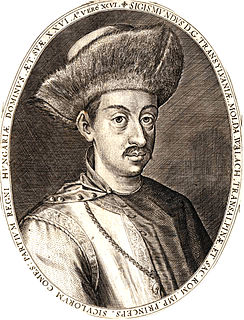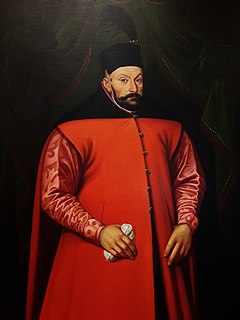 W
WAnna of Foix-Candale was Queen of Hungary and Bohemia as the third wife of King Vladislaus II.
 W
WBálint Bakfark was a Hungarian composer of Transylvanian Saxon origin, and lutenist of the Renaissance. He was enormously influential as a lutenist in his time, and renowned as a virtuoso on the instrument.
 W
WTamás Bakócz was a Hungarian archbishop, cardinal and statesman.
 W
WJános Bánfihunyadi, better known by his Latinized name Johannes Banfi Hunyades or his pseudonym Hans Hungar, was a Hungarian alchemist, chemist and metallurgist. He emigrated to England in 1608 and built a reputation among the academic circles of England and Hungary, associating with such figures as the alchemist Arthur Dee, astrologer William Lilly, physician Jonathan Goddard and scientist Kenelm Digby
 W
WChristopher Báthory was voivode of Transylvania from 1576 to 1581. He was a younger son of Stephen Báthory of Somlyó. Christopher's career began during the reign of Queen Isabella Jagiellon, who administered the eastern territories of the Kingdom of Hungary on behalf of her son, John Sigismund Zápolya, from 1556 to 1559. He was one of the commanders of John Sigismund's army in the early 1560s.
 W
WCountess Elizabeth Báthory de Ecsed was a Hungarian noblewoman from the noble family of Báthory, who owned land in the Kingdom of Hungary.
 W
WGriselda Báthory (1569-1590) was a Hungarian and Polish noble, the daughter of Christopher Báthory, and third wife of Jan Zamoyski.
 W
WSigismund Báthory was Prince of Transylvania several times between 1586 and 1602, and Duke of Racibórz and Opole in Silesia in 1598. His father, Christopher Báthory, ruled Transylvania as voivode of the absent prince, Stephen Báthory. Sigismund was still a child when the Diet of Transylvania elected him voivode at his dying father's request in 1581. Initially, regency councils administered Transylvania on his behalf, but Stephen Báthory made János Ghyczy the sole regent in 1585. Sigismund adopted the title of prince after Stephen Báthory died.
 W
WStephen Báthory was Voivode of Transylvania (1571–1576), Prince of Transylvania (1576–1586), King of Poland and Grand Duke of Lithuania (1576–1586).
 W
WGáspár Bekes de Kornyát was a Hungarian nobleman who fought Stephen Báthory for the throne of Transylvania after the death of John II Sigismund Zápolya in 1571. Allied with Maximilian II, Holy Roman Emperor, and the Székelys, Bekes organized two rebellions against Báthory, but was defeated. After Báthory became King of Poland and Grand Duke of Lithuania in 1576, Bekes reconciled with Báthory, becoming his close adviser. Bekes also fought in the Danzig rebellion and the Livonian War.
 W
WStephen Bocskai or Bocskay was Prince of Transylvania and Hungary from 1605 to 1606. He was born to a Hungarian noble family. His father's estates were located in the eastern regions of the medieval Kingdom of Hungary, which developed into the Principality of Transylvania in the 1570s. He spent his youth in the court of the Holy Roman Emperor, Maximilian, who was also the ruler of Royal Hungary.
 W
WGyörgy Dózsa was a Székely man-at-arms from Transylvania, Kingdom of Hungary who led a peasants' revolt against the kingdom's landed nobility. He was eventually caught, tortured, and executed along with his followers, and remembered as both a Christian martyr and a dangerous criminal. During the reign of king Vladislas II of Hungary (1490–1516), royal power declined in favour of the magnates, who used their power to curtail the peasants' freedom.
 W
WCount Tamás Erdődy de Monyorókerék et Monoszló, also anglicised as Thomas Erdődy, was a Hungarian-Croatian nobleman, who served as Ban of Croatia between 1583-1595 and 1608-1615 and a member of the Erdődy magnate family. He scored significant victories in wars against the Ottoman Empire's armies.
 W
WSigismund Ernuszt was Bishop of Pécs in the Kingdom of Hungary from 1473 to 1505. Ernuszt was also Ban of Croatia, Dalmatia and Slavonia from 1494 to 1498. He was the son of John Ernuszt, a converted Jew, who started his career as a custom's duty collector during the reign of Matthias Corvinus, King of Hungary. Sigismund studied at the universities of Vienna and Ferrara in the early 1470s. When the king made him bishop of Pécs, the Holy See confirmed him as the administrator of the diocese, but he was most probably never ordained bishop. Matthias Corvinus also tasked him with the administration of the newly conquered Archduchy of Austria in 1486.
 W
WFerenc Tahy de Tahvár et Tarkő, was a Croatian and Hungarian nobleman from the Tahy family, which draws its origins from Pilis County. He was known to have held the positions of royal adviser and master of the horse. His cruel treatment of serfs sparked the Croatian–Slovene Peasant Revolt.
 W
WChristoph Frankopan was a Croatian count from the noble House of Frankopan. As a supporter of King John I of Hungary during the succession crisis between John Zápolya and Ferdinand Habsburg, he was named the ban of Croatia in 1526, and died in battle fighting alongside supporters of Zápolya.
 W
WAlvise Gritti, whose first name may also be spelled Aloisio, Lodovico, Ludovico, Luigi or Louis, was a Venetian politician. He was influential in the Hungarian Kingdom under the reign of King John I of Hungary. He was also a minister of the Ottoman sultan, and regent of Hungary from 1530 to 1534. He was the natural son of Andrea Gritti, the Venetian Bailo of Constantinople during the reign of Sultan Bayezid II and who later became the Doge of Venice in 1523.
 W
WGáspár Heltai was a Transylvanian Saxon writer and printer. His name possibly derives from the village Heltau. Despite being a German native speaker he published many books in Hungarian from his print-shop. The brother of his son-in-law was Ferenc Dávid, Nontrinitarian and Unitarian preacher and the founder of the Unitarian Church of Transylvania.
 W
WJohannes Honter was a Transylvanian Saxon, renaissance humanist, Protestant reformer, and theologian. Honter is best known for his geographic and cartographic publishing activity, as well as for implementing the Lutheran reform in Transylvania and founding the Evangelical Church of Augustan Confession in Romania.
 W
WBaron Miklós Istvánffy de Baranyavár et Kisasszonyfalva was a Hungarian politician, Humanist historian and poet, who served as Palatinal Governor of Hungary from 19 January 1582 to November 1608.
 W
WLouis II was King of Hungary, Croatia and Bohemia from 1516 to 1526. He was killed during the Battle of Mohács fighting the Ottomans, whose victory led to the Ottoman annexation of Hungary. He had no legitimate issue.
 W
WGeorge Martinuzzi, O.S.P., was a Croatian nobleman, Pauline monk and Hungarian statesman who supported King John Zápolya and his son, King John Sigismund Zápolya. He was Bishop of Nagyvárad, Archbishop of Esztergom and a cardinal.
 W
WNicolaus Olahus ; 10 January 1493 – 15 January 1568) was the Archbishop of Esztergom, Primate of Hungary, and a distinguished Catholic prelate, humanist and historiographer.
 W
WMaster Paul of Levoča was a medieval carver and sculptor of the 15th and 16th century, active mostly in the town of Lőcse, Kingdom of Hungary.
 W
Wİbrahim Peçevi or Peçuyli İbrahim Efendi or (in Bosnian) Ibrahim Alajbegović Pečevija (1572–1650) was an Ottoman-Bosnian historian-chronicler of the Ottoman Empire.
 W
WPetar Ovčarević was an Ottoman and then Hungarian river flotilla commander, who during his Ottoman service spied and informed the Christian army on the intentions and movements of the Ottoman army. His last years were spent in the Eastern Hungarian Kingdom, as one of the most notable magnates.
 W
WLea Ráskay, O.P., was a Hungarian nun and scholar of the 16th century.
 W
WHadım Suleiman Pasha was an Ottoman statesman and military commander. He served as the viceroy of Ottoman Egypt in 1525–1535 and 1537–1538, and as Grand Vizier of the Ottoman Empire between 1541 and 1544. He was a Hungarian eunuch, his epithet hadım meaning "eunuch" in Turkish.
 W
WGeorge Szatmári de Alsóborsa was a prominent prelate in the Kingdom of Hungary. He was Bishop of Veszprém from 1499 to 1501, of Várad from 1501 to 1505, of Pécs from 1505 to 1522, and Archbishop of Esztergom from 1522 to his death.
 W
WMoses Székely was Prince of Transylvania in 1603.
 W
WAlbert Szenczi Molnár was a Hungarian Calvinist pastor, linguist, philosopher, poet, religious writer and translator.
 W
WGyörgy Szondy was a Hungarian soldier and the captain of Drégely Castle. He was a respected soldier, even by his Turkish foes, whose recognition can be seen by his burial by Hadim Ali Pasha with full military honours.
 W
WAntun Vrančić or Antonio Veranzio was a Croatian prelate, writer, diplomat and Archbishop of Esztergom in the 16th century. Antun Vrančić was from Dalmatian town of Šibenik, then part of the Republic of Venice. Vrančić is also known under his Latinized name Antonius Verantius, while Hungarian documents since the 19th century refer to him as Verancsics Antal.
 W
WMichael Weiß was a Transylvanian Saxon politician and historian. He is mostly known for being the mayor of Kronstadt.
 W
WAnna Wesselényi (1584–1649), was a Hungarian countess and writer. Her correspondence has been published.
 W
WJohn Sigismund Zápolya or Szapolyai was King of Hungary as John II from 1540 to 1551 and from 1556 to 1570, and the first Prince of Transylvania, from 1570 to his death. He was the only son of John I, King of Hungary, and Isabella of Poland. John I ruled parts of the Kingdom of Hungary with the support of the Ottoman Sultan Suleiman; the remaining areas were ruled by Ferdinand I of Habsburg, who also ruled Austria and Bohemia. The two kings concluded a peace treaty in 1538 acknowledging Ferdinand's right to reunite Hungary after John I's death, though shortly after John Sigismund's birth, and on his deathbed, John I bequeathed his realm to his son. The late king's staunchest supporters elected the infant John Sigismund king, but he was not crowned with the Holy Crown of Hungary.
 W
WJohn Zápolya, or John Szapolyai, was King of Hungary from 1526 to 1540. His rule was disputed by Archduke Ferdinand I, who also claimed the title King of Hungary. He was Voivode of Transylvania before his coronation, from 1510 to 1526.